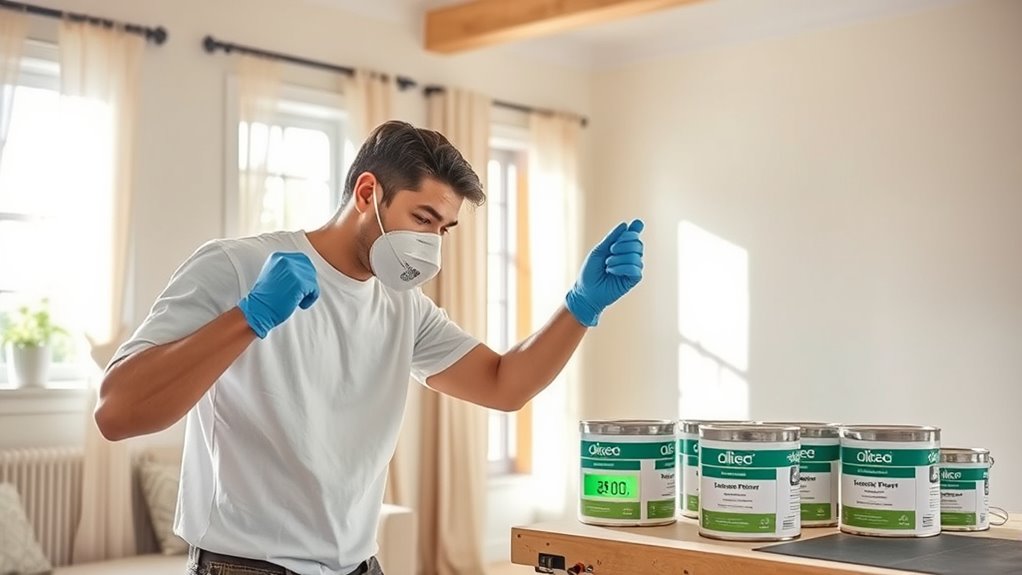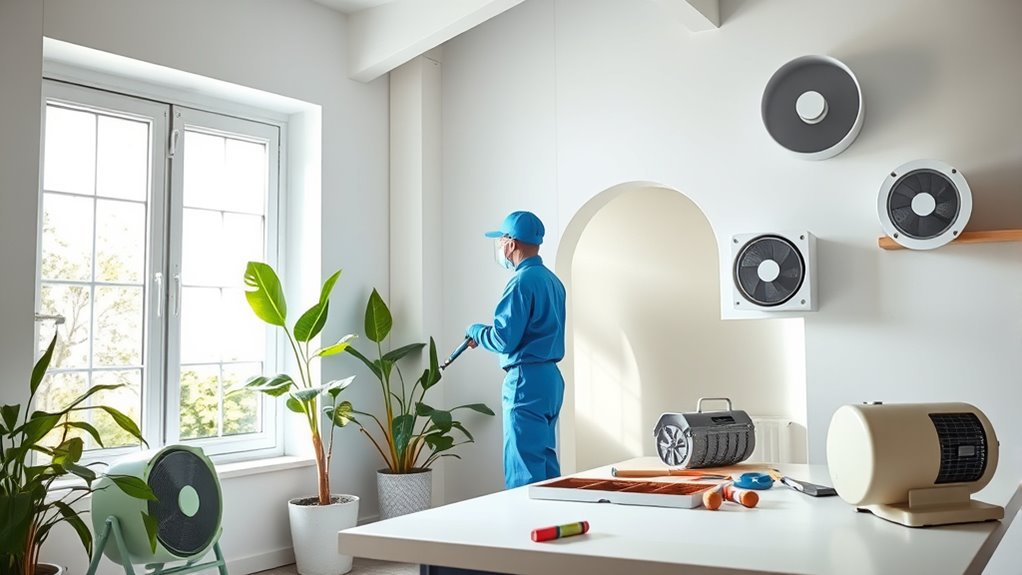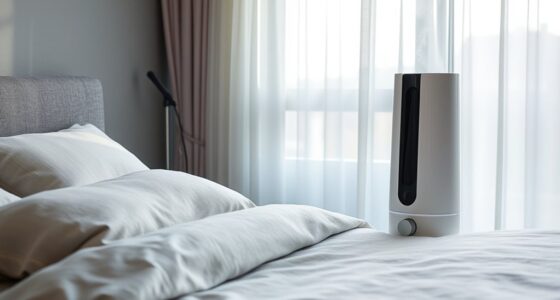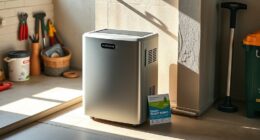To reduce VOC exposure during home renovations, choose low or zero VOC paints, adhesives, and flooring to limit chemical emissions. Ventilate your space well by opening windows and using fans, especially during and after work. Running air purifiers with activated carbon filters continuously helps capture fumes before they settle. By making safer material choices and maintaining good airflow, you can protect your health and create a safer indoor environment. If you want to learn more about effective strategies, keep exploring these options.
Key Takeaways
- Use air purifiers with activated carbon filters continuously during and after renovation to remove airborne VOCs.
- Select low or zero VOC paints, adhesives, and flooring to minimize chemical emissions.
- Ensure proper ventilation by opening windows and using fans during and after renovation activities.
- Complete chemical-intensive work before occupancy, allowing residual fumes to dissipate fully.
- Educate yourself on VOC sources and choose safer products to reduce long-term indoor air pollution.

Have you ever wondered how to lower your exposure to volatile organic compounds (VOCs)? If you’re planning a home renovation, it’s crucial to evaluate strategies that minimize your contact with these harmful chemicals. VOCs are released from many common building materials and paints, but you can take proactive steps to reduce their presence in your living space. One of the most effective methods is investing in air purifiers designed specifically to filter out airborne VOCs. Choose models with activated carbon filters, as they excel at capturing chemical fumes and odors. Running these air purifiers throughout your renovation process and afterward helps maintain cleaner indoor air, protecting your health and promoting a safer environment for you and your family.
Another critical step is selecting low VOC paints for your walls and ceilings. Traditional paints often contain high levels of VOCs, which can linger long after application, releasing fumes that cause headaches, dizziness, or respiratory irritation. Low VOC paints contain fewer chemicals, making them a healthier option that still offers a wide range of colors and finishes. When you’re purchasing paint, look for labels indicating low or zero VOC content, and always follow the manufacturer’s instructions for proper application and curing times. Proper ventilation during and after painting also speeds up off-gassing, further reducing exposure.
Choose low or zero VOC paints for safer indoor air quality during renovations.
Beyond air purifiers and low VOC paints, you should also pay attention to other materials and products used during renovation. Opt for adhesives, sealants, and flooring options labeled as low or no VOC. These products emit fewer harmful fumes, contributing to better indoor air quality. Ventilating your space well during and after renovation is equally important; open windows and use fans to facilitate air exchange. This helps disperse any residual fumes from paints, cleaning agents, and construction materials.
Finally, evaluate timing your renovation projects to minimize exposure. If possible, complete painting and chemical-intensive work before moving into the renovated space, allowing ample time for off-gassing. When you do move back in, keep monitoring indoor air quality and continue using air purifiers to maintain a healthy environment. By making deliberate choices—selecting low VOC paints, using air purifiers, and ensuring proper ventilation—you actively reduce your exposure to VOCs and create a safer, healthier home environment during and after your renovation. Additionally, being aware of volatile organic compounds (VOCs) and their sources can help you make more informed decisions to protect your indoor air quality.
Frequently Asked Questions
How Can I Identify Hidden Sources of VOCS in My Home?
You can identify hidden VOC sources in your home by using air quality sensors to monitor VOC levels regularly. Additionally, consider professional chemical testing, which detects hidden or off-gassing materials like furniture, paints, or cleaning products. Check for signs like persistent odors or headaches, and investigate areas with recent renovations or new items. Combining these methods helps you pinpoint and address hidden VOC sources effectively.
Are There Specific Brands of Low-Voc Products Recommended?
Choosing low-VOC products is like finding a clear stream in a crowded forest. You should look for brands that specialize in eco-friendly flooring and low-VOC paints, such as Benjamin Moore’s Natura or AFM Safecoat. These brands prioritize non-toxic ingredients, making your home safer. Always check labels for VOC content, and opt for products that are explicitly labeled eco-friendly or low-VOC to guarantee you’re making healthier choices.
What Are the Long-Term Health Effects of VOC Exposure?
Long-term VOC exposure can lead to serious health issues like chronic respiratory problems and neurological impacts. You might experience ongoing breathing difficulties, coughing, or dizziness, and over time, it can affect your brain function, causing headaches, memory issues, or concentration problems. Protect yourself by minimizing exposure, especially during renovations, to reduce the risk of these chronic health effects and maintain your overall well-being.
Can Ventilation Alone Eliminate Indoor VOCS Effectively?
Ventilation alone isn’t enough to eliminate indoor VOCs effectively. Studies show that proper air exchange can reduce VOC levels by up to 50%, but adding filtration systems improves this markedly. Air exchange helps remove contaminated air, yet filtration traps VOC particles, making your indoor air safer. To truly lower VOC exposure, combine ventilation with high-efficiency air purifiers, ensuring cleaner, healthier indoor environments during and after renovations.
How Often Should Air Quality Be Tested During Renovation?
You should perform air quality monitoring regularly throughout your renovation, especially at key stages or if VOC levels seem high. Aim for testing at least once a week or whenever you complete a major phase. This helps guarantee your renovation safety protocols are effective. Consistent monitoring keeps you aware of potential hazards, allowing you to take prompt action to reduce VOC exposure and maintain a healthier indoor environment during your renovation.
Conclusion
By taking these simple steps, you can keep VOC fumes at bay and breathe easier during your home renovations. Think of it as steering clear of a storm—your vigilance keeps you safe and your air clean. Remember, every small effort adds up to a healthier home environment. Don’t let hidden pollutants cloud your space; instead, stay proactive and make your renovation a fresh gust for everyone involved.








